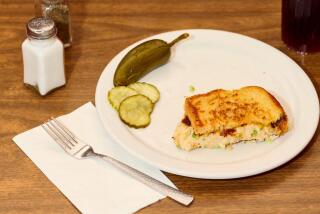The A List: Color It Yellow, Orange and Green
- Share via
Dear Eating Right: What is the difference between Vitamin A and beta carotene? Should I take supplements or can I get enough from food?
--JAMES DAVIS
West Covina
Dear James: If you eat a normal, balanced diet, chances are you don’t need a supplement. Healthy people can get all the Vitamin A the body needs from food. In fact, some health experts warn against taking supplements. They say Vitamin A can build up to toxic levels in your body over long periods of time.
Vitamin A is found in an assortment of yellow and orange fruits and vegetables including apricots, peaches, cantaloupe, sweet potatoes, pumpkin and squash. Dark leafy greens including broccoli and spinach are also good sources.
Some animal foods contain Vitamin A, but they are frequently high in fat. These include liver, cod-liver oil, butter, egg yolks, whole or fortified milk, cream, and cheeses made from whole milk or cream.
Most ready-to-eat and instant cereals are fortified with Vitamin A, too. Usually, these contain about 25% of the Recommended Dietary Allowance of the vitamin, which is 1,000 retinol equivalents daily for the average man, 800 RE daily for women. Pregnant women need more Vitamin A and children require less.
Like most other vitamins, Vitamin A is actually made up of several components: the active form and its precursors, which are changed into the active form in the body. For instance, beta carotene, the orange pigment found in brightly colored plants, is a precursor.
Because Vitamin A is fat-soluble, when you eat food that is rich in either its active form or beta carotene, the nutrient is stored in the liver and fatty tissues for future use by cells. It is good for your eyes; it moisturizes the eye tissues and helps you see in dim light. It is needed for bone and tooth development, reproduction and immunity. Plus, Vitamin A has been credited with protecting the body from some cancers including lung, stomach, bladder, colon and prostate.
Cooking and prolonged storage can deplete the amount of Vitamin A in the foods you buy, so serve fruits and vegetables raw whenever possible. Otherwise, try to steam, bake, broil and braise instead of frying. Store them covered in the refrigerator until ready to use.
To help you get more fruits and vegetables in your diet, the California Department of Health Services offers two free brochures: “Eat More Fruits and Vegetables” suggests ways you can incorporate fruits and vegetables into your breakfast, lunch and dinner meals; and “Easy Entertaining With Fruits and Vegetables” includes holiday gift ideas and recipes for desserts and appetizers.
For a copy of either booklet, write to Nutrition and Cancer Prevention Program, California Department of Health Services, 1008 10th St., Sacramento, Calif. 95814.
On e serving of Yams/Sweet Potatoes and Carrots a L’Orange supplies twice the RDA for Vitamin A. For a sweeter dish, use yams; for color contrast sweet potatoes are best.
YAMS/SWEET
POTATOES AND
CARROTS A L’ORANGE
2 cups thinly sliced, peeled sweet potatoes or yams
1 cup sliced peeled carrots
1/2 cup orange juice
1 teaspoon lemon juice
1 teaspoon cornstarch
1 tablespoon water
1 teaspoon honey
1 teaspoon grated orange zest
Salt
2 tablespoons slivered almonds or chopped pecans, toasted
Boil or steam sweet potatoes (or yams) and carrots until tender. Heat orange juice to boiling. Add lemon juice. Dissolve cornstarch in water and add to orange juice mixture. Stir in honey, then continue to heat, stirring until thickened. Stir in orange zest.
Remove vegetables from pan and place in serving dish. Drizzle sauce over, season to taste with salt and sprinkle nuts on top. Makes 4 servings.
NUTRIENT ANALYSIS FOR VITAMIN A Calories Fat Cholesterol Type of Food (Grams) (Milligrams) Equivalents) Breads, Cereals, Grain Products Oatmeal, instant, fortified, 1 packet prepared 105 2 0 Fruits Apricot nectar, canned (1 cup) 140 0 0 Apricots, raw (3 whole) 50 0 0 Cantaloupe, (1/2 melon) 95 1 0 Purple plums, canned in juice (1/2 cup) 72 0 0 Nectarines, raw (1 whole) 65 1 0 Mangoes, raw (1 whole) 135 1 0 Vegetables Broccoli, cooked, drained from frozen (1 cup) 45 0 0 Carrots, raw (1 whole) 30 0 0 Collards, cooked from frozen (1 cup) 60 1 0 Winter Squash, baked (1 cup) 80 1 0 Sweet Potatoes, boiled with- out skin, (1 potato) 160 0 0 Meat and Meat Alternates Liver, fried, beef, (3 ounces) 185 7 410 Oysters, raw (1 cup) 160 4 120 Milk, nonfat (1 cup) 90 1 5
NUTRIENT ANALYSIS FOR VITAMIN A Vitamin A Type of Food (Retinol Equivalents) Breads, Cereals, Grain Products Oatmeal, instant, fortified, 1 packet prepared 453 Fruits Apricot nectar, canned (1 cup) 591 Apricots, raw (3 whole) 277 Cantaloupe, (1/2 melon) 861 Purple plums, canned in juice (1/2 cup) 127 Nectarines, raw (1 whole) 100 Mangoes, raw (1 whole) 806 Vegetables Broccoli, cooked, drained from frozen (1 cup) 350 Carrots, raw (1 whole) 2,025 Collards, cooked from frozen (1 cup) 1,017 Winter Squash, baked (1 cup) 7,290 Sweet Potatoes, boiled with- out skin, (1 potato) 2,575 Meat and Meat Alternates Liver, fried, beef, (3 ounces) 9,120 Oysters, raw (1 cup) 233 Milk, nonfat (1 cup) 149
Source: United States Department of Agriculture, Handbook 8.
More to Read
Eat your way across L.A.
Get our weekly Tasting Notes newsletter for reviews, news and more.
You may occasionally receive promotional content from the Los Angeles Times.










